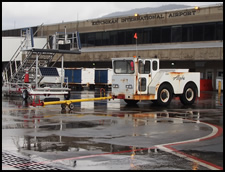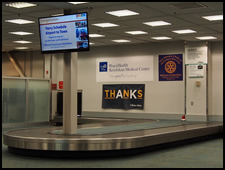Ketchikan International Airport - Partnership Agreement

Lease Agreement (ADA-05175)
Experience has shown that the title of the document as “Lease Agreement” may not be wholly accurate because the lease covers more than real property. The provisions of the agreement require coordination, support and cooperation amongst multiple sections of DOT&PF. Perhaps a more accurate title would have been “Airport Operating Agreement & Lease” as the document is predominantly concerned with the operation, maintenance, development, and financing of the airport.
The following is a summary of the most significant provisions of the current lease agreement (ADA-05175):
Click on the links below to go to section of interest
1. Entire Airport Leased
The entire airport (not including the ferry terminal and vessels) is part of the leased premises, including the building sites, the airfield and the industrial development area.
2. Lease Term
The term of the lease runs until May 31, 2027.
3. Day-to-Day Maintenance (Section 6)
KGB is obligated to perform all routine maintenance of the following
|
|
4. Joint Inspections (Section 6)
In order for both KGB and DOT&PF to be involved with airport welfare, both parties are to conduct joint inspections of the airport to determine compliance with the airport maintenance lease requirements. In a joint inspection, DOT&PF’s team would include representatives from at least M&O (maintenance issues), Design (engineering issues), and Leasing (lease interpretation and compliance).
5. Major Maintenance & Repair (Section 6)
Each party has different maintenance and repair responsibilities. Both parties are engaged in airport welfare and in turn are provided some financial protection. The responsibilities and benefits are listed below:
KGB |
DOT&PF |
Responsibilities
|
Responsibilities
|
Benefits
|
Benefits
|
DOT&PF can at 5-year intervals, change the dollar threshold for major maintenance or repair when the Engineering News Record Construction Index increases or decreases. DOT&PF has never adjusted this threshold amount.
6. Compliance With FAA Rules (Section 8)
Both parties in the partnership are co-operators of the airport. KGB is required to comply with applicable FAA regulations but did not want to be solely responsible for compliance. FAA in turn was unwilling to entirely release DOT&PF from its obligations as the airport sponsor.
7. Airport Enterprise Fund (Section 9)
KGB is required to deposit into the Airport Enterprise Fund, all airport related revenue such as:
|
|
The money in the fund is then prioritized for use:
1st priority
- Operating and airport maintenance costs
- Airport capital expenditures
- Ferry operating costs
- Airport-related debt service
2nd priority
- Deposit in the Airport Reserve Fund for paying operating costs in future years when costs exceed revenue; preventing spending airport revenue for non-airport purposes
DOT&PF has the right to inspect or audit the fund records at any time. Setting up a fund was forward thinking because later, the FAA adopted regulations and sanctions against revenue diversion by airport owners / operators.
Maintaining a balance in the Reserve Fund and keeping airport operating costs low; enables KGB to
- Have reserve funds available during years when airport revenue is insufficient to cover costs
- Obtain the balance of the reserve fund upon the normal expiration of the lease in 2027; first, for the retirement of bonds related to the airport and, then for any public purpose.
8. Annual Reports (Section 10)
KGB is required to submit to DOT&PF by October 15th an annual audit report of airport revenues and expenses. DOT&PF is kept informed of the financial health of KGB’s airport operations. If a problem is identified early, steps can be taken to correct it before it becomes a major issue.
9. Compliance with FAA Grant Requirements (Section 17)
KGB is required to discharge all of DOT&PF’s obligations under FAA airport improvement grants, but acknowledges that DOT&PF remains ultimately responsible to the FAA for those obligations. The FAA was unwilling to relieve DOT&PF of its grant obligations and transfer them to KGB so long as DOT&PF retained ownership of the airport. DOT&PF remains the Airport Sponsor when it comes to obtaining FAA grant funds for projects at KTN.
The lease is subject to the requirements of FAA grants, but only to the extent that DOT&PF has made written disclosure of the grants to KGB and furnishes copies to KGB. DOT&PF has the obligation to keep KGB informed of new grants and any new grant requirements.
10. Termination by KGB (Section 20)
KGB may terminate the lease if DOT&PF fails to perform its obligations under the lease or if a situation of “fiscal insufficiency” occurs.
“Fiscal insufficiency” is a condition where KGB’s airport operating costs
- Exceed revenue by 35% in a single fiscal year
- Exceed revenue by an average of 20% for any two of four consecutive fiscal years.
KGB is provided an escape if the economics of the airport take a major decline; however both parties are engaged in the airports welfare in that:
- KGB has a way out of the lease only in the event of major financial losses.
- DOT&PF has an incentive to closely watch the airport’s financial condition and take action to provide direction or give financial aid to KGB before the termination thresholds are reached.
11. Disposition of Improvements & Bonded Indebtedness at the End of the Lease
(Section 21)
Various scenarios exist, by which either party may terminate the lease.
Scenarios |
|
|
|
These scenarios provide both parties with incentives to preserve the lease and the operational well-being of the airport. Disposition of improvements, revenue fund balances, and bonded indebtedness are set up such that neither party has an incentive to cancel the lease, except under extremely serious circumstances.
This history was compiled with assistance from Steve Pavish, who began his career with the Alaska airport system in 1973 in the real estate branch of the Division of Aviation, Department of Public Works. Mr. Pavish was a key member of the original KTN lease negotiation team, and held responsibility for supervising the KTN lease until his retirement in 1999.



